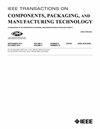Direct Die-to-Die Bridging for Heterogeneous mm-Wave Circuits Enabled by Fused-Silica Stitch-Chip Technology
IF 3
3区 工程技术
Q2 ENGINEERING, ELECTRICAL & ELECTRONIC
IEEE Transactions on Components, Packaging and Manufacturing Technology
Pub Date : 2025-07-10
DOI:10.1109/TCPMT.2025.3587609
引用次数: 0
Abstract
This work presents a novel direct die-to-die (D2D) interconnect approach utilizing fused-silica stitch-chip technology to integrate heterogeneous commercial off-the-shelf (COTS) chiplets without the need for die embedding. This study evaluates RF performance through simulations and experimental measurements, comparing the stitch-chip interconnect against both wire-bond and other interconnect technologies. In addition, this study analyzes the impact of die embedding within a cavity on its performance. A heterogeneous integration of a low-noise amplifier (LNA) die (GaAs) and a switch die (AlGaAs), both designed for K-/Ka-band applications, is demonstrated using stitch-chip technology. RF characterization results verify that the bare LNA die maintains strong performance, achieving greater than 12-dB return loss (RL). The integrated LNA-switch module achieves a 20-dB linear gain up to 38 GHz, with the D2D stitch-chip interconnect showing a 4-dB improvement in gain compared to the die-to-package-to-die (D2P2D) approach and an 8.5-dB increase in gain compared to wire-bond connections. The results demonstrate that the proposed stitch-chip technology effectively minimizes insertion loss (IL), improves impedance matching, and enhances RF signal integrity, positioning it as an up-and-coming solution for future heterogeneous RF/mm-wave multichip integration applications.采用熔融硅缝片技术实现非均匀毫米波电路的直接模对模桥接
这项工作提出了一种新的直接模对模(D2D)互连方法,利用熔融二氧化硅缝合芯片技术集成异构商业现成(COTS)芯片,而无需嵌入模具。本研究通过模拟和实验测量来评估射频性能,将缝片互连与线键和其他互连技术进行比较。此外,本研究还分析了型腔内嵌模对型腔性能的影响。低噪声放大器(LNA)芯片(GaAs)和开关芯片(AlGaAs)的异质集成,都是为K / ka波段应用而设计的,使用缝片技术进行了演示。射频表征结果证实裸LNA芯片保持了较强的性能,实现了大于12db的回波损耗(RL)。集成的lna开关模块实现了高达38 GHz的20 db线性增益,与D2P2D(晶片到封装到晶片)方法相比,D2D拼接芯片互连的增益提高了4 db,与线键连接相比,增益提高了8.5 db。结果表明,所提出的缝片技术有效地减少了插入损耗(IL),改善了阻抗匹配,增强了射频信号的完整性,使其成为未来异构射频/毫米波多芯片集成应用的一个有前途的解决方案。
本文章由计算机程序翻译,如有差异,请以英文原文为准。
求助全文
约1分钟内获得全文
求助全文
来源期刊

IEEE Transactions on Components, Packaging and Manufacturing Technology
ENGINEERING, MANUFACTURING-ENGINEERING, ELECTRICAL & ELECTRONIC
CiteScore
4.70
自引率
13.60%
发文量
203
审稿时长
3 months
期刊介绍:
IEEE Transactions on Components, Packaging, and Manufacturing Technology publishes research and application articles on modeling, design, building blocks, technical infrastructure, and analysis underpinning electronic, photonic and MEMS packaging, in addition to new developments in passive components, electrical contacts and connectors, thermal management, and device reliability; as well as the manufacture of electronics parts and assemblies, with broad coverage of design, factory modeling, assembly methods, quality, product robustness, and design-for-environment.
 求助内容:
求助内容: 应助结果提醒方式:
应助结果提醒方式:


